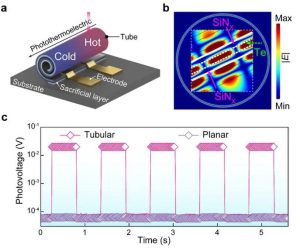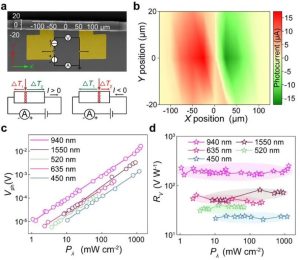Application of lock-in amplifier SE1022 in the measurement of self-rolled three-dimensional photothermoelectric detector
Keywords: photocurrent mapping, lock-in amplifier, self-rolled detector, photothermoelectric effect
Description: This article uses Saluki SE1022 lock-in amplifier for measurement
【Overview】
In July 2024, Mei Yongfeng/Huang Gaoshan from the Department of Materials Science of Fudan University published a research paper entitled “Enhanced photothermoelectric conversion in self-rolled tellurium photodetector with geometry-induced energy localization” in the important optical journal Light: Science & Applications. This study used self-rolling technology to separate tellurium nanofilms as photothermoelectric active materials from substrates and assemble them into three-dimensional tubular self-driven photodetectors, revealing the localization of light and heat energy in the device and the light-heat-electric conversion mechanism on a three-dimensional scale, achieving broadband light detection and sensitivity improvement, and providing an effective solution for multi-dimensional photoelectric detection.
Localizing light and heat energy to achieve efficient photothermoelectric conversion is crucial for high-performance photothermoelectric detection. However, the study of micro-nanoscale devices under the coupling of multiple physical fields, especially the influence of substrates, is facing challenges. As on-chip integrated devices develop towards three-dimensionality, the structure-activity relationship of three-dimensional micro-nano devices needs to be further explored. Using nanofilm peeling technology to construct independent three-dimensional micro-nano structures can effectively localize photothermal energy and provide important support for the practical application of devices.
【Measurement method and some experimental results】
The research team used photothermoelectric active materials and used self-rolling nanotechnology to reassemble the nanofilm separated from the substrate into a three-dimensional curled structure using the longitudinal internal strain gradient of the nanofilm (Figure 1a). Due to the resonance effect, this structure can concentrate the light field energy in the suspended three-dimensional tube wall (Figure 1b), resulting in a larger temperature difference, and then generating a significant potential difference during the thermoelectric conversion process. The experimental results further verified the significant effect of the self-rolled tubular tellurium-based detector (TTD) on improving the light detection performance, and the self-driven photovoltage was increased by 307 times.

The team explored the photothermoelectric effect and its position dependence in the self-curling photothermoelectric detector. Figure 2(a-b) shows the mapping relationship between the position of the incident light in the self-curling photothermoelectric device and the intensity and direction of the generated photocurrent, thus confirming the coupling and conversion efficiency of light, heat and electricity in the three-dimensional structure. Figure 2(c) shows that there is a good linear relationship between the self-driven photovoltage (Vph) of TTD and the incident light power density (Pλ) under laser irradiation of different wavelengths, which confirms the sensitivity of TTD to light and its self-driven photodetection capability in a wide wavelength range. Figure 2(d) shows the change of the voltage response (RV) of TTD with the incident light power density (Pλ) under laser irradiation of different wavelengths. Under 940 nm laser irradiation, the RV of TTD reached 252.13 V W−1, which is a very high value, indicating that the photothermoelectric conversion efficiency of TTD at this wavelength is very high. In summary, TTD demonstrates its ability to achieve self-driven photodetection in an ultra-wide band from visible light to long-wave infrared. The self-powered nature of TTD means that it can operate without the need for an external power source, which facilitates portable and remote light detection applications.

Figure 2: Photothermoelectric effect verification of self-curling detector: a-b. Schematic diagram and experimental results of the spatial coordinate system used in the study, as well as the position dependence of the photogenerated current; c-d. Relationship curves between the incident light power and the self-driven photogenerated voltage and voltage responsivity under multi-wavelength excitation.
All photoresponse measurement results in this study, including photocurrent mapping, photovoltage line scanning, and other optoelectronic characteristics, were measured by MStarter 200 probe station, Keysight B2902B, and lock-in amplifier (Saluki SE1022).
【Summarize】
This research used three-dimensional self-curling nanotechnology and combined it with thermoelectric functional materials to successfully design and manufacture a new self-curling three-dimensional photothermoelectric detector. The three-dimensional tubular structure significantly enhances light absorption and thermal localization effects, and improves light-heat-electricity conversion efficiency through locally concentrated photothermal energy. This self-curling photothermoelectric detector not only has high sensitivity and wide spectral response range, but also has unique functions such as self-driving, omnidirectional detection and polarization imaging, which indicates its huge application potential in on-chip integrated optoelectronic systems.
【Reference】
✽ Jiayuan Huang, Chunyu You, Binmin Wu, Yongfeng Mei, Gaoshan Huang* et. al., Enhanced photothermoelectric conversion in self-rolled tellurium photodetector with geometry-induced energy localization. Light: Science & Applications, 2024, 13(1), 153.



